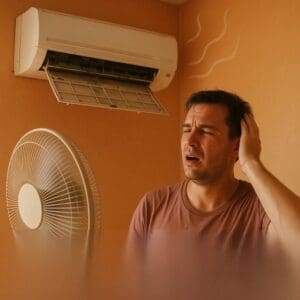What to Do When Your Air Conditioner is Too Hot to Handle
It always happens at the worst time. The temperature’s soaring, the sun’s beating down, and suddenly, your air conditioner stops working. For homeowners, this isn’t just an inconvenience—it’s a full-blown emergency. If you have children, elderly family members, or pets, the health risks multiply quickly in a heatwave. And if you’ve ever tried to book a service call during the peak of summer when other homeowners are having the same problem, you know wait times can skyrocket.
 Air conditioner breakdowns are a miserable experience.[/caption]
Air conditioner breakdowns are a miserable experience.[/caption]
Here’s what you can do if your A/C breaks down—and when it’s time to call Stith Plumbing and HVAC.
Step 1: Check Your Thermostat
Start simple. Make sure the thermostat is set to “cool” and the temperature is set below the room temperature. If it’s battery-operated, change the batteries. You’d be surprised how many service calls are solved by a quick thermostat check.
Step 2: Inspect the Circuit Breaker
Check your home’s electrical panel to make sure the breaker for the A/C unit hasn’t tripped. If it has, reset it. If it trips again soon after, that’s a sign of an electrical issue or an overworked compressor—something that needs a professional’s touch.
Step 3: Examine the Air Filter
A dirty air filter can suffocate your system. Replace it with a clean one and see if the airflow improves. In many cases, this alone can stop the unit from freezing up or cycling off prematurely.
Step 4: Check the Outdoor Unit
Is it covered in leaves or debris? Is the fan turning? Clear any obstructions, and if you feel comfortable, rinse the fins with a gentle hose spray (turn the system off first). If the fan isn’t running at all, the motor or capacitor might have failed.
Step 5: Let It Rest
If the system has frozen (ice on the indoor coil or lines), turn it off and let it thaw completely before restarting. This can take several hours. Sometimes, a frozen system is caused by low refrigerant or restricted airflow, both of which need professional attention.
Step 6: Restart the System
Once you’ve completed the steps above, try restarting the system. Set the thermostat to a few degrees cooler than room temperature and listen. Does the blower start? Does cool air come out of the vents? If not, it’s time to make the call.
When It’s Time to Call Stith Plumbing and HVAC
If you’ve walked through the checklist and the house is still hot, you need expert help. Here’s when you should reach out to Stith:
- The unit won’t turn on at all
- There’s a burning smell or sparks
- You hear loud banging, clanking, or screeching sounds
- Ice keeps forming on the lines
- Warm air is blowing from the vents
- You’ve already replaced the filter and checked the breaker
Stith Plumbing and HVAC offers fast, reliable service—even in the peak of summer. Their certified technicians arrive on time, treat your home with respect, and explain every repair clearly before they begin.
Prevent Future Breakdowns
To avoid future stress and cost, consider a routine maintenance plan. Seasonal A/C inspections can catch minor problems before they become major ones. Stith offers a maintenance program that keeps your system running efficiently, helps lower your energy bills, and extends the life of your equipment.
Final Thought
You shouldn’t have to sweat through the summer or pay for emergency repairs that could’ve been avoided. When your A/C goes down, act fast, stay calm, and follow the steps above. And if you need backup, Stith Plumbing and HVAC is always ready to help.
